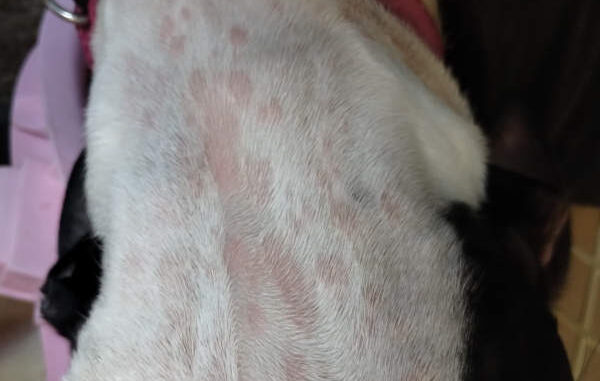
This article was updated on February 1st, 2024
In our veterinary clinic, we see patients with belly rashes on a daily basis. When dealing with this issue, it’s important to remember that a belly rash is a symptom, not a diagnosis. Therefore, especially if a rash is bothersome or recurrent, your veterinarian will need to identify and treat the underlying health issue causing the rash.
Let’s explore the top causes of belly rashes in dogs (with pictures) and learn what to do next!
Top causes of a belly rash on a dog (with pictures)
1. Allergies
While allergies in people often cause sneezing and watery eyes, they usually affect the skin of our furry family members, leading to a rash, among other clinical signs. Skin issues as a result of allergies can occur anywhere on the body, but in many cases are more visible to pet parents on the belly where there is less fur.
The most common allergies in dogs include environmental allergies (pollen, dust mites, etc), food allergies (particularly to beef, dairy, and chicken), and flea allergies. It is also common for dogs to have more than one type of allergy.
How do you know if your dog’s belly rash is due to allergies? Pictured below are examples of red, irritated skin and secondary skin infections, due to underlying allergies:
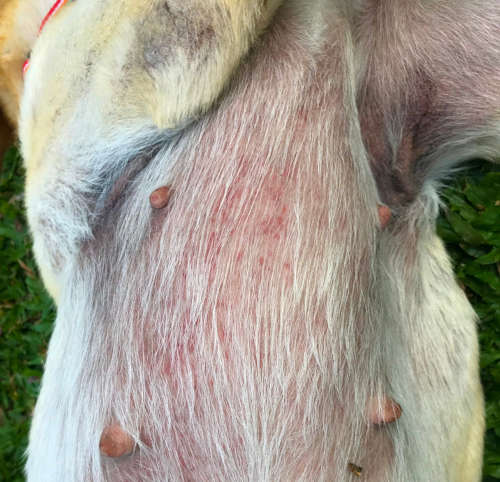
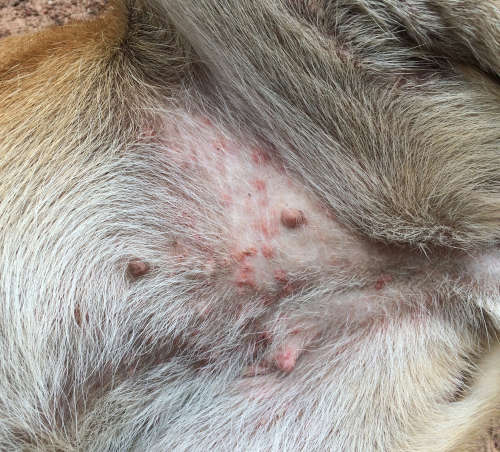

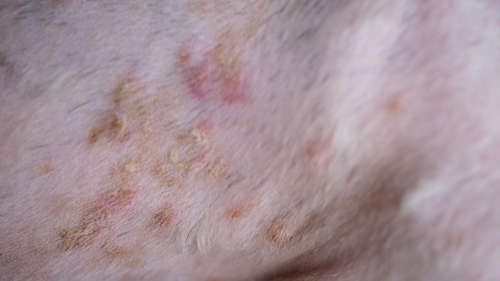
Frequent clinical signs of allergies include:
- Itchy skin and resulting trauma due to excessive chewing, licking, and scratching
- Inflamed and infected skin, which may lead to redness, oozing, or crusty scabs, and pustules (pimples)
- Recurrent or chronic skin and ear infections
- Chronic allergies may lead to thickening and pigmentation of the skin and salivary staining (brown discoloration) of the fur.
- In dogs with flea allergies, live fleas or flea dirt may or may not be seen.
- Dogs with food allergies may or may not have accompanying gastrointestinal signs such as vomiting or diarrhea.
- Dogs with environmental allergies may have a seasonal pattern to their symptoms.
Flea allergies: While fleas can cause itchy skin in any dog, those who have a flea allergy can develop a significant reaction to the bite of even a single flea. This condition is known as flea allergy dermatitis (FAD), and it is the most common skin disease of dogs and cats in the United States.
The image below shows a typical example of FAD, with red, irritated skin, scabbing, and hair loss at the base of the tail. Of course, lesions can also present anywhere on the body, including the belly.
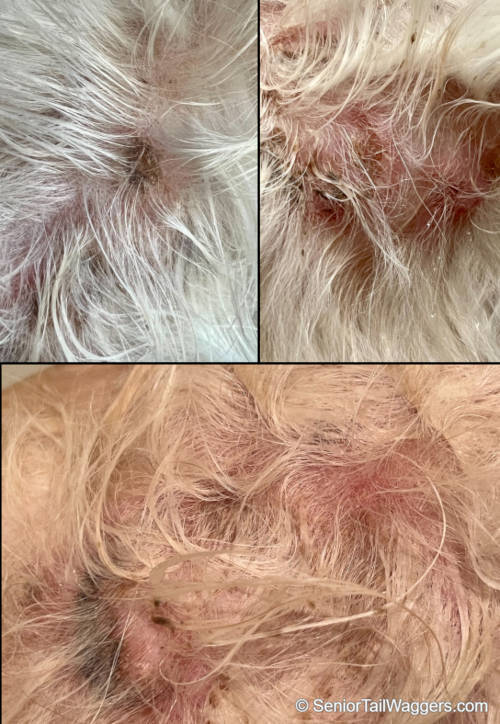
Food allergies: Dogs can develop allergies to something in their diet, most commonly the protein source (for example, chicken or beef). Allergies can develop in dogs of any age, even if your dog has been doing well on the same diet for years, but are most common in young adults. Pictured below is a belly rash as a result of a food allergy:
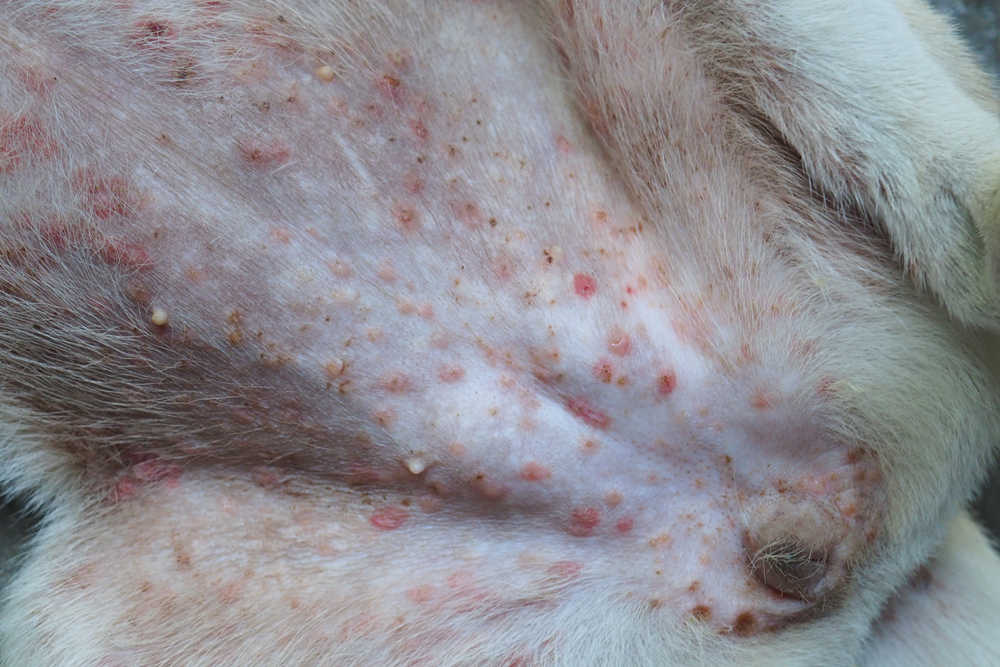
Environmental allergies: Environmental allergies, also known as atopy, are another common allergy seen in dogs. Dogs may be allergic to many things, such as pollen, dust, or even cats. While any breed of dog can develop atopy, some are more predisposed than others. Additionally, clinical signs tend to develop in young adults between six months and three years of age.
2. Contact dermatitis
Contact dermatitis is a localized reaction to something that comes in contact with your dog’s skin. The source may vary depending on what your dog is sensitive to, for example, rolling in the grass or sleeping on bedding washed with a new laundry detergent.
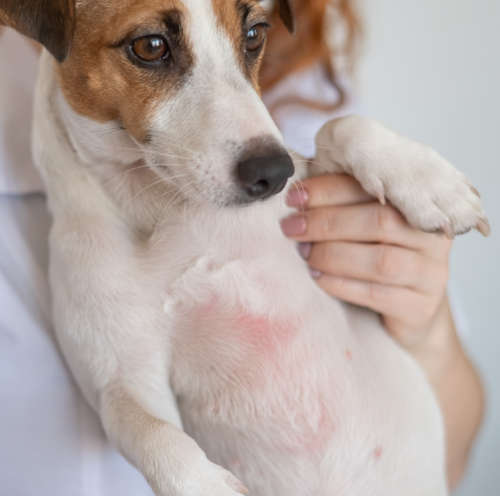
Additionally, some substances are caustic or irritating and could actually cause chemical burns or damage the skin. Depending on the severity, your dog may require topical or oral medications to help decrease itchy skin and inflammation; however, it is important to identify and remove the underlying cause to prevent recurrence.
3. Skin infection (pyoderma)
Skin infections are very common in dogs and a frequent cause of belly rashes in dogs. Skin infections can be caused by bacteria, yeast, or fungus. They can occur when the skin barrier is damaged (due to a cut, trauma, moisture, allergies, or other underlying conditions). Signs may include:
- redness,
- hair loss,
- scabbing,
- pustules (pimples), and
- itchy skin.
Here is a typical example of belly rash caused by a skin infection:
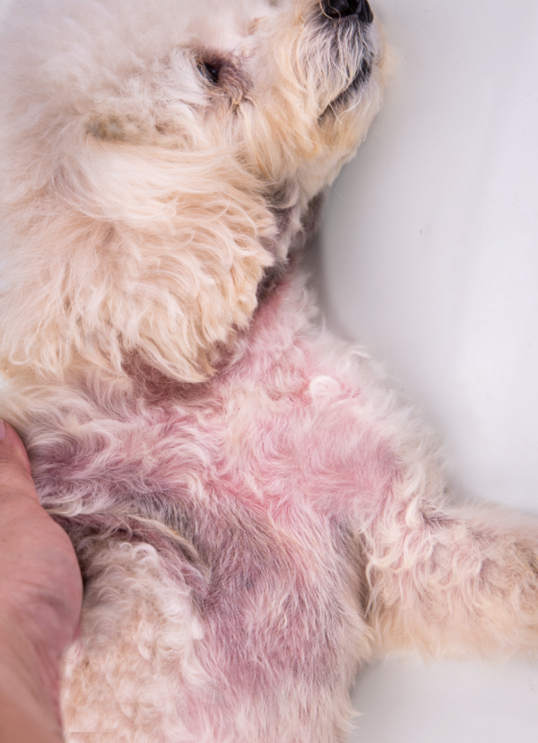
Cytology (examining a sample from the skin under a microscope) and/or culture (growing the bacteria or organism that is present), can be used to diagnose a skin infection and help your vet choose an appropriate topical or oral medication, such as antibiotics.
Learn more about Skin Infections (Pictures & Treatments)
Hot spots or acute moist dermatitis
Hot spots are painful, swollen, red areas of hair loss that occur on a dog’s skin. They can occur due to an allergic reaction, fleas, or even due to stress, and are exacerbated by self-trauma from scratching, biting, and licking excessively. The size of a hot spot on a dog can vary greatly, but they typically range from about the size of a coin to several inches in diameter.
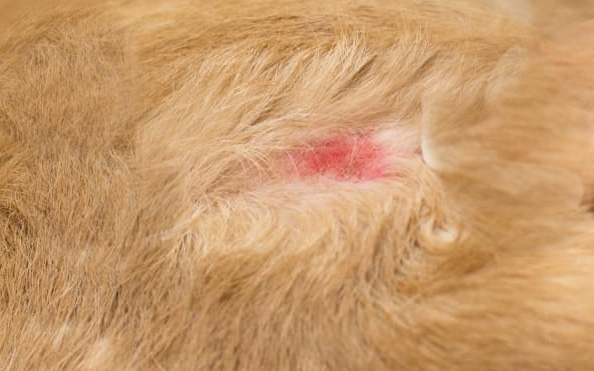
View more pictures
These hot spots can quickly become large and are often associated with hair loss, skin infection, and discomfort, thus requiring a veterinary exam and treatment (often consisting of clipping and cleaning the area, topical medications, antibiotics, anti-inflammatories, and an E-collar to prevent additional damage). View more pictures of hot spots on dogs.
Puppy pyoderma
Puppy pyoderma is a mild skin infection common in puppies. It typically appears as small, pimple-like bumps or sores on the skin, usually in the groin, abdomen, and armpits.
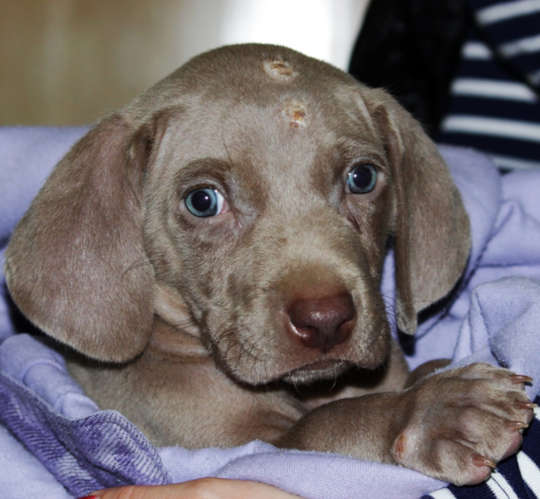
Affected pups may experience itchiness and discomfort, and the sores can sometimes ooze pus. These superficial infections typically resolve with use of antibacterial shampoos or topical creams, and in more severe cases, a course of antibiotics may be needed.
4. Parasites or insect bites
Parasites such as fleas or mites and insect bites can have a significant impact on your dog’s skin and are a frequent cause of belly red rashes on dogs.
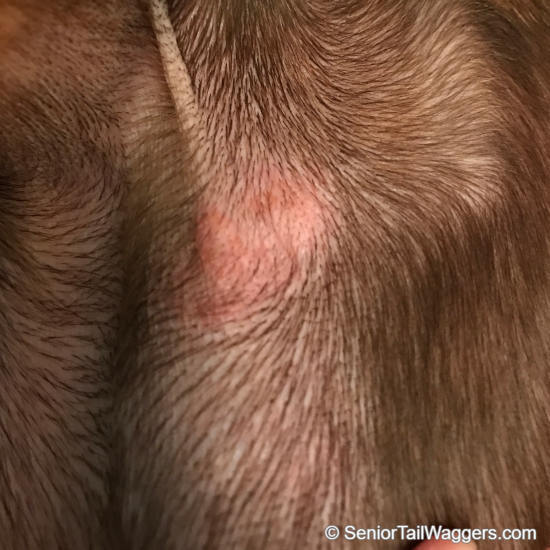
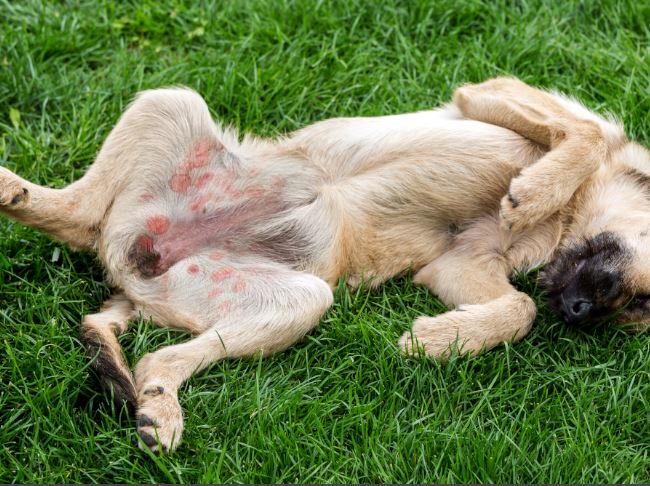
Examples of mites include demodex and scabies. Demodectic mange is caused by a mite and can lead to areas of patchy hair loss (especially around the face and eyes), in puppies or immunocompromised adult or senior dogs.
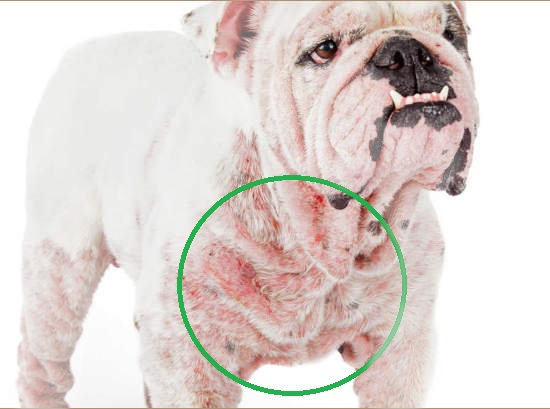
Sarcoptic mange is a highly contagious mite that causes intense itching and hair loss. Both conditions can also lead to secondary skin infections and skin rash. Additionally, black fly bites can cause circular red skin lesions, which are often most noticeable on the abdomen or other areas with less fur. Treatment options include prescription oral or topical medications.
The image below depicts black fly bites on a dog’s belly:
5. Heat rash
Sometimes dogs can get heat rash, which typically appears on their belly as red, tender, itchy skin with scabs, sores, and bumps. Dogs don’t sweat like people and rely on panting to stay cool. Heat rash can be a sign that your dog is overheating or spending too much time in the sun, which could lead to life-threatening heat stroke.
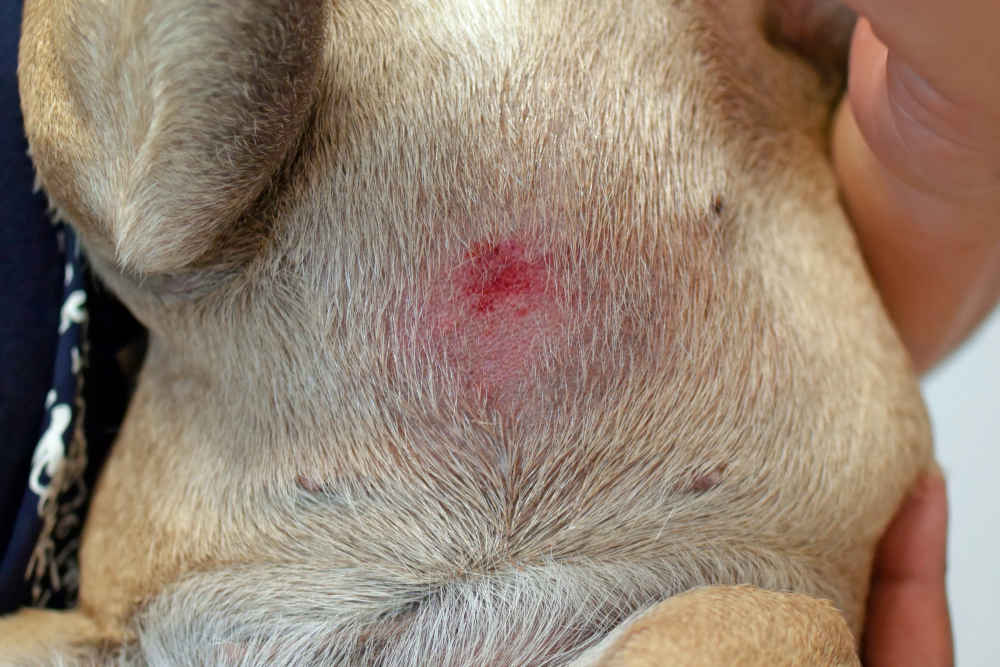
While in some cases heat rash can be treated at home with cool towels and ointments, it is important to see your veterinarian for a diagnosis to rule out other causes of rash.
6. Hormonal imbalance
Hypothyroidism, a condition in which the thyroid gland doesn’t produce enough hormones, can lead to hair loss, lethargy, weight gain, and a dull hair coat. Cushing’s disease (hyperadrenocorticism), on the other hand, is caused by an overproduction of the stress hormone cortisol.
It often results in thinning hair, darkened skin, a pot-bellied appearance, and increased thirst and urination. Cushing’s can also cause a skin condition known as calcinosis cutis, which causes hard bumps in the skin due to calcium deposits. Both conditions can also predispose dogs to skin infections. They can be diagnosed through blood tests and managed with medications.
The image below is a dog with Cushing’s Disease. Note the thinning fur coat and pot-bellied appearance.

7. Urinary incontinence or infection
Urine scald is a painful skin rash that occurs when urine contacts the skin (usually around the genitals, back legs, and lower abdomen) for long periods of time, causing red, irritated skin and secondary infection. It is most often seen in dogs who are paralyzed or dealing with urinary incontinence for another reason (for example, a urinary tract infection or hormonal issue).
However, it can also be seen in dogs with birth defects, or who are suffering from other debilitating systemic diseases affecting their mobility and causing them to lay in puddles of urine. Urine scald requires veterinary attention to treat, as well as diagnose and resolve the underlying condition to prevent recurrence.
See this picture showing a urine scald (on dundies.com.au) and secondary infection from a dog wearing a poor-fitting diaper (learn more about diaper rashes).
8. Bleeding disorder
Petechiae are tiny, pinpoint-sized hemorrhages that occur under the skin, and may be confused for a rash in some cases. They’re typically red, purple, or brown spots that can be seen through the skin or the mucous membranes, such as the gums. While not specific to the belly, this may be an area where petechia are more visible as it is less haired. The presence of petechia can be a sign of a serious health problem, such as thrombocytopenia (low platelets), certain infectious disease, cancer, or poisoning.
These images show petechia on a dog’s gums and abdomen due to immune-mediated thrombocytopenia.
Mild belly rashes can be treated at home
If your dog’s sympoms are mild, they may respond to at-home treatment. However, if their condition is not improving or your dog appears significantly itchy, uncomfortable, or develops other clinical signs, veterinary evaluation and treatment will be needed. In any case, we always recommend that you call your vet before starting any home remedy. At-home care may include:
- Weekly bathing with medicated shampoo, such as Duoxo S3
- Monthly flea prevention for all pets in the household, year-round
- Omega 3 fish oil and Benadryl (or another antihistamine) may help with mild itch. Your vet can provide information on an appropriate dosage.
- Reduce exposure to allergens in your home by avoiding perfumes and keeping the area free of dust. Wiping off paws after coming in from outdoors can also be helpful.
When to see the veterinarian
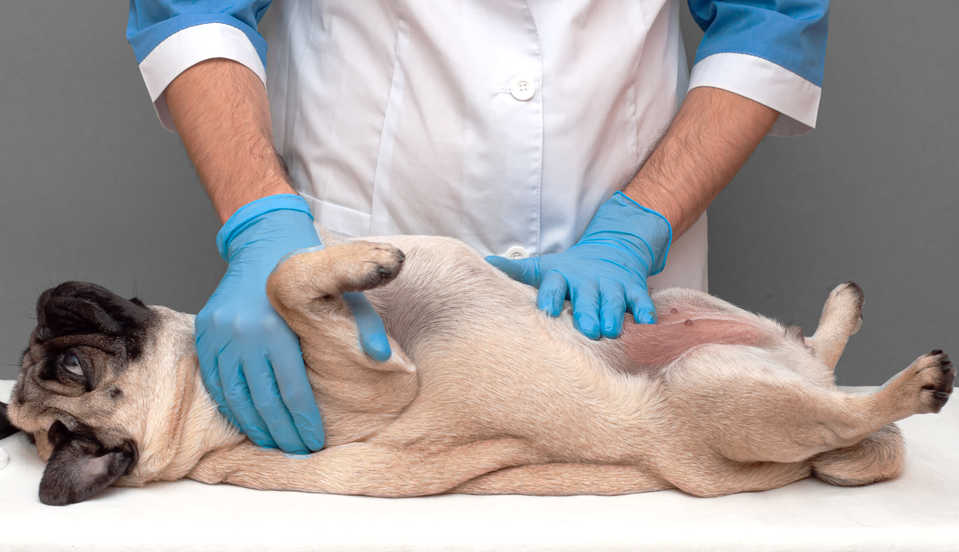
If your dog is itchy and uncomfortable, it is best to see your vet as soon as possible. Most cases of belly rash are not emergent and will resolve with appropriate treatment. However, there are a few cases that can be associated with more serious underlying disease. If you are concerned or notice additional clinical signs such as weakness, vomiting, diarrhea, or loss of appetite you should seek urgent care.
Veterinary diagnostics
Before your vet can appropriately treat your dog’s belly rash, they must determine the underlying cause. This may include the following:
- Thorough history – It is important that you provide your vet with details about your dog’s symptoms and lifestyle, including how long the rash has been going on, if your dog appears itchy, their current diet, and any other health concerns.
- Nose-to-tail physical exam – During this exam, your vet will evaluate your dog’s skin and hair to look for evidence of skin infection or parasites, lesions on the skin, and the distribution and appearance of the rash.
- Skin cytology – Your vet may collect a sample from the skin for evaluation under the microscope. This may be done by pressing a glass microscope slide against the skin or using a piece of tape to collect skin cells. In the case of an ear infection, they will take a swab of debris from your dog’s ear. Evaluation under the microscope can determine if it is yeast, bacteria, or both that are causing the infection.
- Bacterial or fungal culture – This can be used to grow the organism that is causing infection and help determine which medications it will respond to.
- Skin scraping – This is another way to collect a small skin sample to look for the presence of mites (Demodex or Scabies) under the microscope.
- Elimination diet trial – Food allergies can be diagnosed by feeding a hydrolyzed or novel protein diet for three months.
- Allergy testing – If you wish to pursue allergy injections (allergen-specific immunotherapy), skin testing performed by a dermatologist will determine what your dog is allergic to. In some cases, a blood test may also be beneficial.
- Biopsy – In more severe cases or those resistant to treatment, a larger piece of skin may be removed via a punch biopsy for evaluation by a specialist.
- Bloodwork – Routine bloodwork and urine testing will help your vet evaluate your dog’s overall systemic health. They may also recommend additional testing to check your dog’s thyroid function and test for Cushing’s Disease or bleeding disorders.
Veterinary treatments
Possible treatments may include:
- Topical antibiotics and/or antifungals to treat infection – including shampoos, sprays, wipes, or ointments
- Oral antibiotics and/or antifungals if more severe infection is present
- Medications to help decrease pruritus and inflammation in the skin, such as steroids, Apoquel, or Cytopoint
- An E-collar to keep your dog from causing further damage to the area during the healing process
While there is no cure for allergies, they can generally be managed using a combination of the below treatments. Newer medications, such as Apoquel and Cytopoint, have made a big difference in keeping allergy dogs happy and comfortable. The goal of treatment is to reduce the severity and frequency of flare-ups and symptoms.
- Year-round flea prevention for all pets in the household
- Hydrolyzed protein or novel protein diet for dogs with food allergies
- Allergen-specific immunotherapy for environmental allergies
- Medications such as Apoquel and Cytopoint may be used long-term to manage allergy symptoms
- Medical treatment for other systemic disease
Disclaimer: This website's content is not a substitute for veterinary care. Always consult with your veterinarian for healthcare decisions. Read More.


Be the first to comment